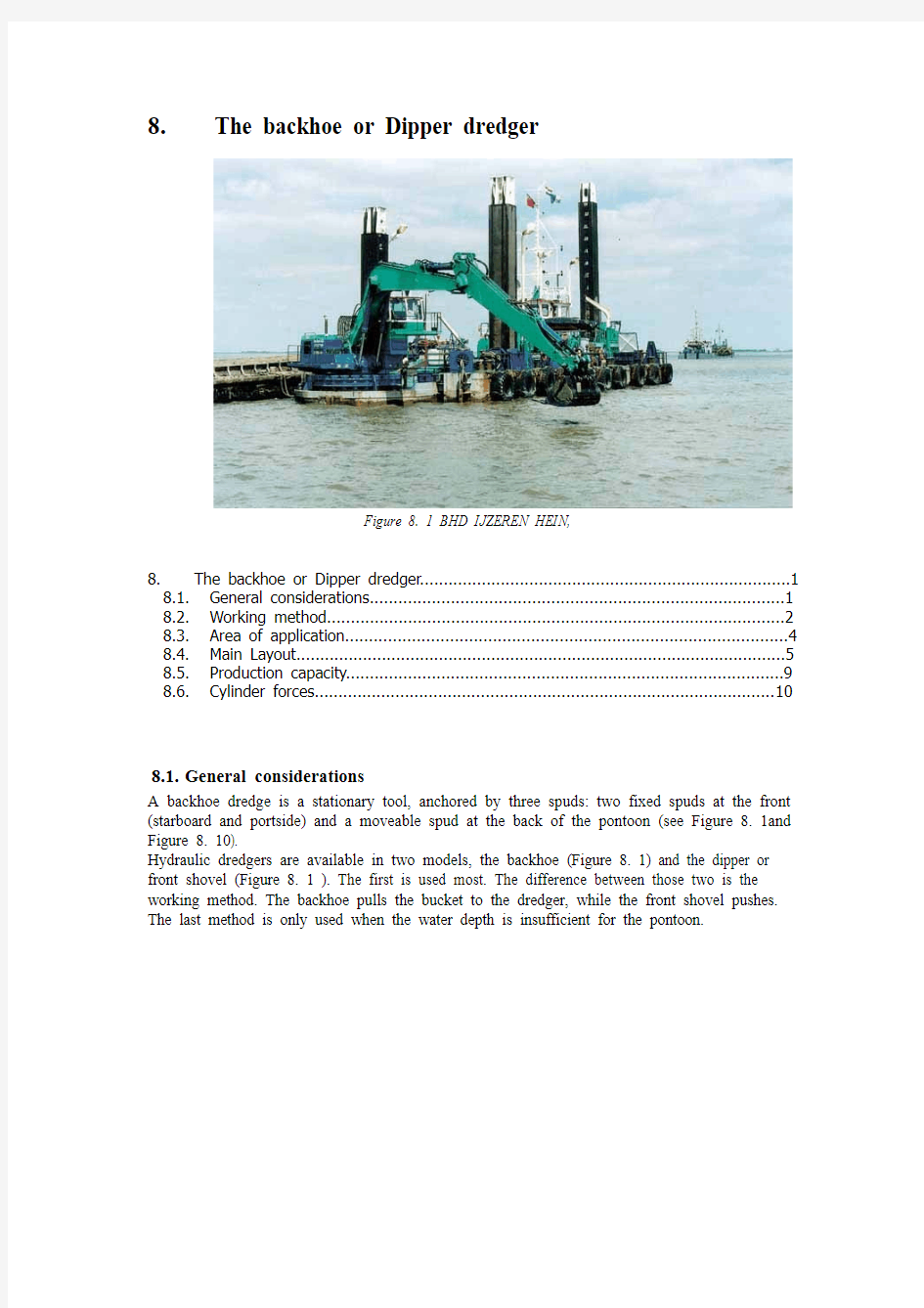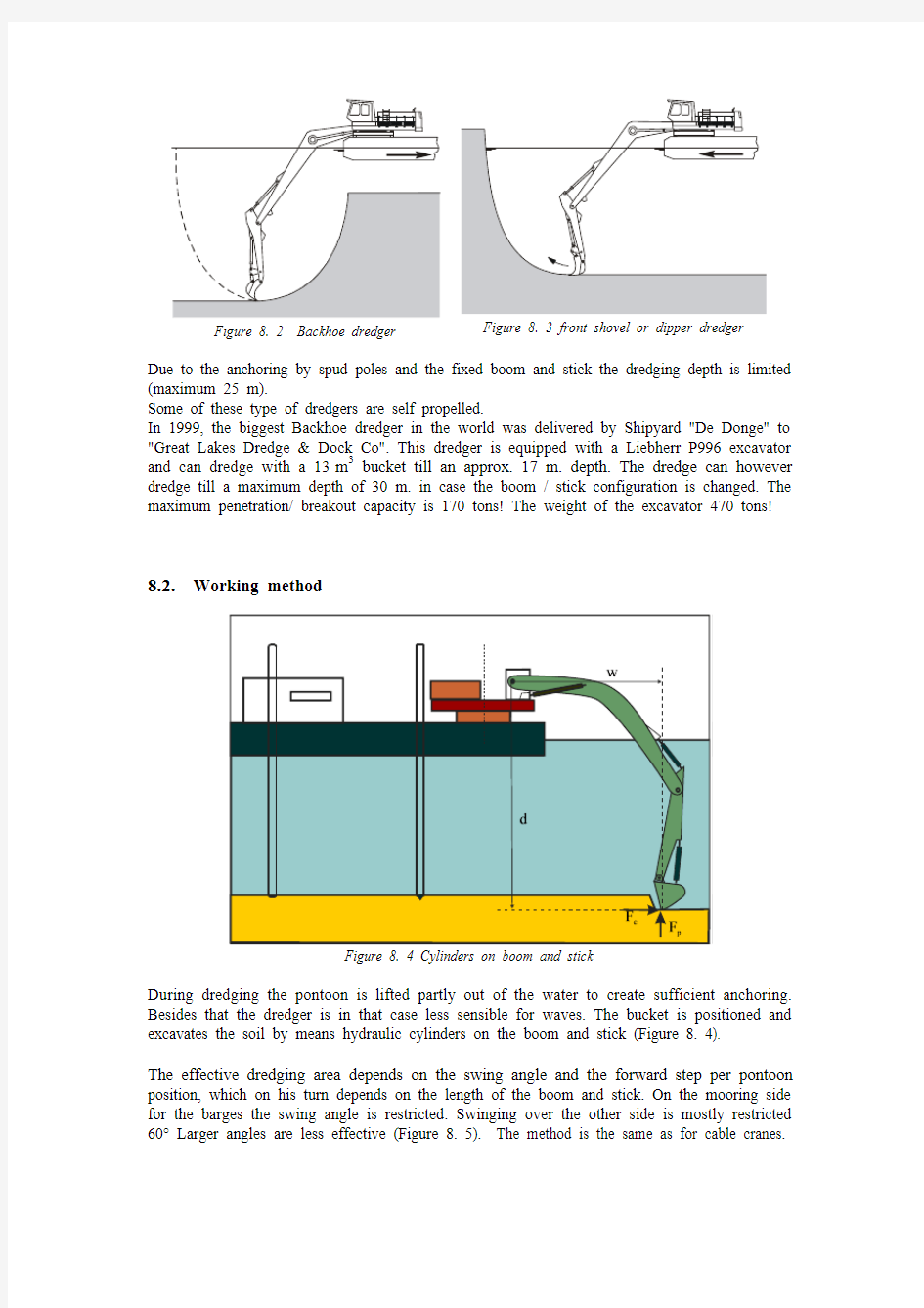vlasblom8-the-backhoe-or-dipper-dredger


8.
The backhoe or Dipper dredger
Figure 8. 1 BHD IJZEREN HEIN,
Figure 8. 1Figure 8. 1
8. The backhoe or Dipper dredger..............................................................................1 8.1. General considerations.......................................................................................1 8.2. Working method................................................................................................2 8.3. Area of application.............................................................................................4 8.4. Main Layout.......................................................................................................5 8.5. Production capacity............................................................................................9 8.6. Cylinder forces. (10)
8.1. General considerations
A backhoe dredge is a stationary tool, anchored by three spuds: two fixed spuds at the front (starboard and portside) and a moveable spud at the back of the pontoon (see Figure 8. 1and ).
Figure 8. 10Hydraulic dredgers are available in two models, the backhoe () and the dipper or front shovel ( ). The first is used most. The difference between those two is the working method. The backhoe pulls the bucket to the dredger, while the front shovel pushes. The last method is only used when the water depth is insufficient for the pontoon.
Due to the anchoring by spud poles and the fixed boom and stick the dredging depth is limited (maximum 25 m).
Some of these type of dredgers are self propelled.
In 1999, the biggest Backhoe dredger in the world was delivered by Shipyard "De Donge" to "Great Lakes Dredge & Dock Co". This dredger is equipped with a Liebherr P996 excavator and can dredge with a 13 m 3 bucket till an approx. 17 m. depth. The dredge can however dredge till a maximum depth of 30 m. in case the boom / stick configuration is changed. The maximum penetration/ breakout capacity is 170 tons! The weight of the excavator 470 tons!
8.2. Working method
Figure 8. 4 Cylinders on boom and stick
Figure 8. 4
During dredging the pontoon is lifted partly out of the water to create sufficient anchoring. Besides that the dredger is in that case less sensible for waves. The bucket is positioned and excavates the soil by means hydraulic cylinders on the boom and stick ().
The effective dredging area depends on the swing angle and the forward step per pontoon position, which on his turn depends on the length of the boom and stick. On the mooring side for the barges the swing angle is restricted. Swinging over the other side is mostly restricted 60° Larger angles are less effective (). The method is the same as for cable cranes.
Figure 8. 5
Cut projection
Top view cut The forward step per pontoon
positions can be sub-divided in
bucket forward positions (Step)
and bucket swing positions
(width) (Figure 8. 1). A small
step results in a large width and
a large step in a small width to
fill the bucket, however the total
volume is almost the same.
positions
Due to the radius of the boom Array and arm the cut width is limited
to 10 to 30 m, see (Figure 8. 7).
The dredge has sometimes more
than one boom and/or sticks. A
shorter boom and / or stick
result in higher excavating
forces.
Figure 8. 7 The reach of the dredger for
different booms & sticks
1.
8.3.Area of application
Backhoes are used in soil types like firm clay, soft rock, blasted rock and when large stones
can be expected, like the removal waterside protections. The length of the stick and the boom determines the dredging depth. Some backhoes have more than one bucket to be able to dredge well at several depths. The lack of anchorage cables limits the hindrance for other ships and there is also no delay for anchorage.
Hydraulic backhoes are especially suitable for accurate dredge work, due to the construction
of the stick and the boom.
In general this dredge tool cannot be used under offshore conditions, due to the limited
pontoon width.
Since there are several ways of defining the volume of the buckets one has to be aware when
ordering one. The definitions are (Figure 8. 8):
?struck capacity (water volume): this is the amount of water that the bucket can hold at
maximum when the upper bucket rim is held horizontal.
?heaped capacity (SAE volume (SAE = Society of Automotive Engineers)): in this an extra amount of soil with embankment slopes of 1:1 is calculated in.
?heaped capacity CECE volume (CECE = Committee of European Construction Equipment): same as above but with embankment slopes of 1:2.
Figure 8. 8 Different capacities
Mainly the type of soil determines the filling degree of the bucket. In soft and sticky soils the bucket is heaped, while in rock due to the shape of the boulders only a part of the bucket is filled. Besides, the bulking (volume increase) from the soil plays a role too.
Soil type Filling degree Bulking factor Soft clay 1.5 1.1 Hard clay 1.1 1.3
Sand & Gravel 1 1.05 Rock; well blasted 0.7 1.5 Rock, unblasted 0.5 1.7
8.4. Main Layout
The crane is positioned on the front side of the pontoon on the “turning table ”, which situated just above water level. This part is a compromise between the required freeboard and the maximum available excavating force. The required reaction forces for excavations are delivered by the spud-poles.
The crane on the turning table is mostly from a well-known brand (Demag, Liebherr, O&K Poclain, etc.), which can be delivered in modules (). The boom and stick are constructed more heavy duty than those for land operations. Marine operations results in higher and more dynamic loads due to deep excavation depths.
Bucket sizes vary from several cubic meters to 20 m 3. The spud are provided with a hoisting system to hoist the spuds from the sea bed as well as to lift the pontoon partly out of the water to increase
the transfer of the reaction forces to the
soil
Figure 8. 9 Shovel modules Figure 8. 1
The aft spud is either placed in a carriage () or is executed as a walking spud ().
Figure 8. 10Figure 8. 11
The engine room and the accommodation is place at the stern. .
Figure 8. 10 General plan BHD IJZEREN HEIN
The backhoe dredge IJzeren Hein is equipped with a Liebherr P 984 crane and is build under the classification of Burea Veritas I 3/3 (-) ? Pontoon NP/Deep Sea.
Figure 8. 11 Plan view BHD ROCKY, Owner BOSKALIS
The BHD Rocky, one of the most powerful backhoes, is provided with a DEMAG H 286S excavator with 1230 kW and can be equipped with bucket varying in size between3 and 16 m3. She has a dredging depth of 25 m. The aft spud is executed as a walking spud.
Data from existing backhoe dredgers shows that there is hardly a relation between bucket size and installed diesel power as well as between diesel power and lightweight (Figure 8. 12 and ).
Figure 8. 13
Lightweight of the pontoon is some what related to the total power installed (, while lightweight is roughly 47 % of the pontoon volume ( and ).
Figure 8. 16Figure 8. 17
Data from excavator suppliers shows a better relation.
Figure 8. 14Figure 8. 15
With and a better estimate of the installed power is possible then from . Figure 8. 12
Figure 8. 16 Pontoon volume versus lightweight
Length-width ratio and width-draught ratio are almost the same as for the pontoons of the grab dredgers (). Figure 8. 17Figure 8. 17 Lightweight versus pontoon dimensions.
8.5.Production capacity
When dredging soft soils (free running sand, silt and soft clay) the volume per bite of the bucket is determined by the bucket capacity. For harder materials the cylinder forces can be the decisive factor.
If the cylinder force is F c and the cutting speed v c and the specific energy of the soil is SPE then:
F v SPE Q V
t
d step W
t
c c s
bucket
digging layer bucket
digging
?===
??
With:
Q s Production m3/s
V bucket Bucket capacity m3
T digging Excavating time s
d layer Thickness layer m
Step Step
size m
W bucket Width of bucket m
The cutting speed can be calculated either by rotating the bucket or the stick.
Cycle times of the bucket depends on the dredging depth and soil type, but are in the order between 20 and 40 seconds.
The cycle consists of:
?Digging
?Lifting and swinging
?Dumping
?Swinging and lowering
?Positioning.
The step procedure takes more time, 5 to 10 minutes.
STEP PROCEDURE FOR BACKHOE DREDGERS
No. Spud carriage Walking spud
1 Lower pontoon into the floating position Lower pontoon into the floating position
2 Put the bucket into the soil Put the bucket into the soil
3 Lift front spuds Lift front spuds
4 Move pontoon one step forward by
moving the carriage and the stick. Move pontoon one step forward by tilting the walking spud and pulling the stick.
5 Set front spud into the soil Set front spud into the soil
6 Lift movable spud Lift walking spud
7 Move carriage one step forwards Tilt waling spud back into its middle
position
8 Set the movable spud into the soil Lower walking spud
9 Lift pontoon in working position Lift pontoon in working position
Points 6, 7 and 8 for the spud carriage system are only necessary when the stroke of the cylinder to move the carriage is used.
8.6. Cylinder forces
The cutting forces are calculated either by the specific energy concept or by the cutting theories for sand, clay or rock. The cutting theories give the normal forces too, however for sharp knives or teeth only. For design purposes the average normal forces (between sharp and blunt cutting tools) are assumed to be a ratio of the cutting forces. For sand and clay F cutting /F normal =10 and for rock F cutting /F normal =2
If the ratio is known, the cylinder forces can be calculated by taking the moments around the suspension points.
The cylinder force to move the boom follows from the equation (): Figure 8. 18
c p boom boom stick stick bucket bucket
cylinder F d F l W z W z W z F a
?+????=
Finally, the moments and shear forces can be calculated in the boom and stick to depend the dimensions of the boom and stick under dynamic conditions.
